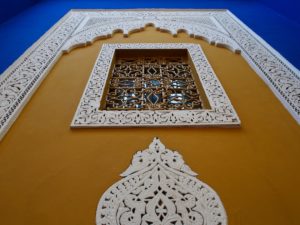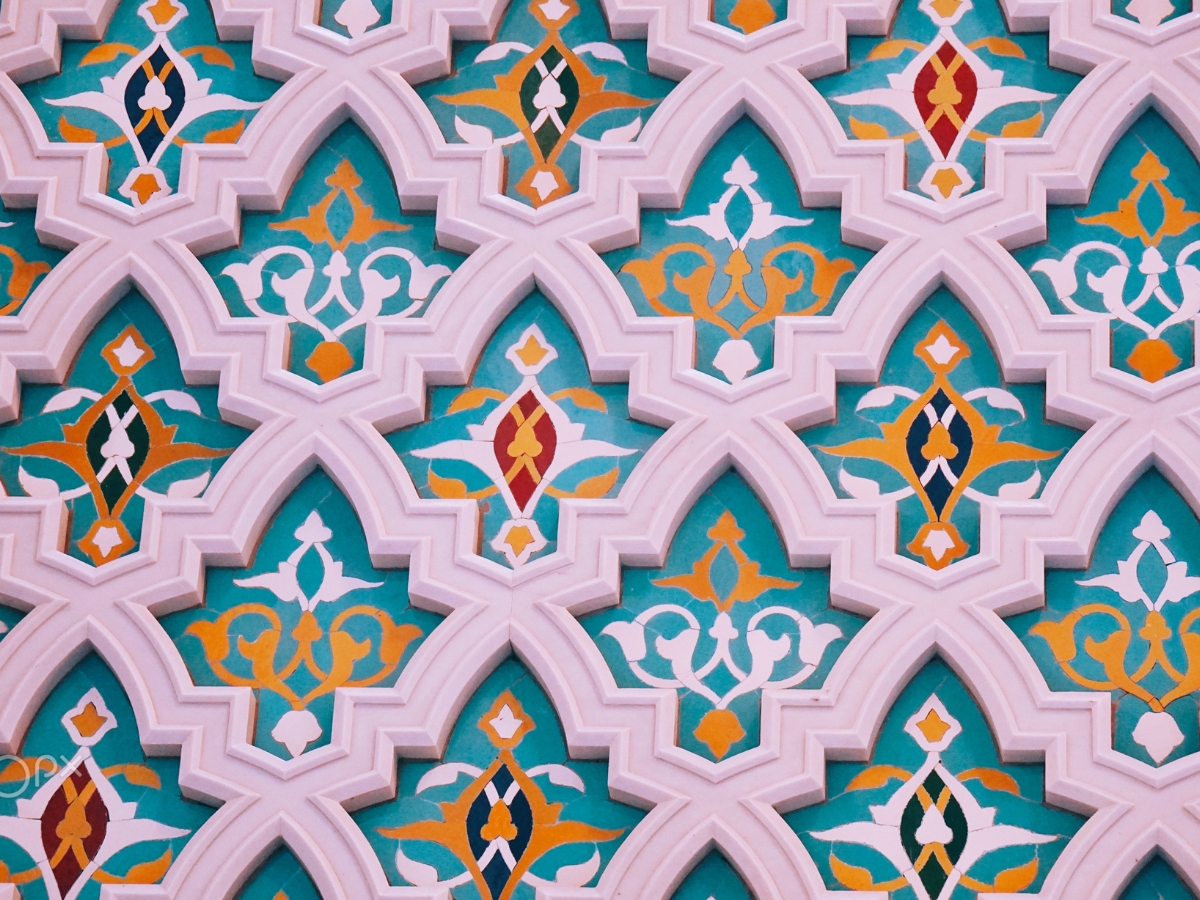Modern Islamic Art is a fascinating blend of traditional and contemporary styles, incorporating ancient techniques with modern concepts. With its rich history dating back centuries, Islamic Art has developed into a diverse and vibrant form that continues to captivate audiences worldwide. From intricate geometric patterns to calligraphy and miniatures painting, modern Islamic Art showcases an array of visually stunning and culturally significant techniques. In this blog post, we’ll explore the evolution of Modern Islamic Art over the years, how it has been influenced by global integration, and highlight some contemporary Muslim artists making waves in today’s creative landscape. So buckle up for an exciting journey into one of the most captivating forms of Middle Eastern Art!
Definition
Islamic Art refers to the artistic traditions created within the Islamic world, from Spain to India and beyond. The term describes various art forms, including architecture, calligraphy, textiles, ceramics, glassware, and metalwork.
Islamic Art’s rich history dates back to the 7th century when Islam emerged in Arabia. It draws upon various cultural influences such as Persian, Roman, and Byzantine styles while incorporating unique features such as geometric patterns and calligraphy.
What sets Islamic Art apart is its focus on spirituality rather than realism. This means that instead of creating lifelike images of people or animals forbidden by Islamic law, artists use abstract shapes and patterns to symbolize religious concepts such as unity with God.
Despite this restriction on figurative representation in Islamic Art, it has proven incredibly diverse, with many different styles emerging. Modern Islamic Art continues this tradition by blending traditional techniques with contemporary ideas – resulting in a dynamic and ever-evolving creative landscape.

How Modern Islamic Art Evolved Over the Years?
Modern Islamic Art has seen a significant evolution in recent years, reflecting the changing perspectives of Muslim artists worldwide, and the early 20th century witnessed an emergence of modernist movements in Muslim-majority countries such as Turkey, Egypt, and Iran that sought to create a new visual language by merging traditional Islamic motifs with contemporary styles.
As globalization took hold in the latter half of the century, Muslims living outside their homelands began forging new ways to express their identities through Art. They created works that celebrated their cultural heritage and their experiences as diaspora communities.
In addition to this, there was also a renewed interest in reviving ancient techniques such as miniature painting, calligraphy, and arabesque design which had been lost or marginalized over time. Today’s contemporary Muslim artists draw from these multiple sources while incorporating international influences.
Modern Islamic Art is no longer confined to religious themes but extends beyond them. Artists are exploring issues like identity politics, social justice, and environmental concerns through thought-provoking pieces. With its diverse forms and techniques rooted in centuries-old traditions blended with newer artistic interpretations, Modern Islamic Art continues to captivate audiences worldwide.
Precedents for Modern Islamic Art
The development of modern Islamic Art has been influenced by several artistic traditions that have roots in the religion. One of the most significant precedents for modern Islamic Art is calligraphy, considered an essential and sacred form of expression in Islam.
Calligraphy in Islamic Art refers to the practice of writing Arabic script using a variety of styles and forms. Many contemporary Muslim artists incorporate calligraphy into their work, creating beautiful pieces reflecting traditional and modern influences.
Another key precedent for modern Islamic Art is geometric patterns. The use of geometric shapes and designs has been a part of Islamic artistic tradition since its earliest days, with many believing these patterns represent unity, harmony, and infinity.
Arabesque designs are also commonly used in contemporary Muslim artwork. These intricate floral motifs can be found throughout traditional architecture across the Middle East and North Africa regions but have evolved to include more abstract forms.
One lesser-known precedent for modern Islamic Art is miniature painting. This delicate style originated during the Mughal Empire (1526-1857) when it was used to illustrate manuscripts depicting scenes from everyday life or religious stories.
Numerous precedents have helped shape contemporary approaches to Islamic Art while remaining true to its rich cultural heritage.
Contemporary Approaches to Islamic Art and Culture
Modern approaches to Islamic Art and culture have brought about diverse perspectives that challenge traditional notions of being Muslim. Through the lens of contemporary Art, artists explore themes such as identity, gender, politics, and spirituality.
Contemporary Muslim artists push boundaries with their work by using new mediums like digital media and installation art. By exploring these new forms, they can represent the complexities of modern Muslim life with stunning visual impact.
Islamic calligraphy has also seen a revival in contemporary Islamic art. Artists use this centuries-old tradition innovatively by incorporating it alongside other artistic elements such as geometric patterns and arabesque designs.
Many contemporary artists draw inspiration from traditional techniques, such as miniature painting, while incorporating modern abstractionism. This creates an exciting intersection between old and new styles that speaks to traditionalists and those seeking something fresh.
Islamic Art is increasingly recognized internationally for its beauty and cultural significance in today’s globalized world. As more people gain exposure to these works through exhibitions, galleries, and social media platforms, there is a growing audience for Muslim artwork worldwide.
Discovering the Diversity of Modern Islamic Art Forms & Techniques
The world of modern Islamic Art is incredibly diverse, encompassing many different forms and techniques. While traditional calligraphy and arabesque designs remain popular, contemporary Muslim artists have also embraced new mediums such as photography, video installations, and graffiti.
One form that has gained popularity in recent years is geometric patterns. These intricate designs often represent the universe’s underlying structure in Islamic Art. They can be found in everything from textiles to architecture to fine Art.
Another technique that has seen a resurgence is miniature painting. This delicate painting originated in Persia over 800 years ago and involved intricate brushwork on small surfaces such as paper or ivory.
Modern abstract Islamic Art is yet another exciting development in the field. Artists with this style may draw inspiration from traditional Islamic motifs but incorporate them into larger abstract compositions that push aesthetic and conceptual boundaries.
There are countless ways for contemporary Muslim artists to engage with their cultural heritage while embracing new forms and techniques. The diversity within modern Islamic Art continues to expand, reflecting the creativity and dynamism of Muslim communities worldwide today.
Style and techniques
Modern Islamic Art encompasses various styles and techniques that have evolved. One of the most distinctive features of Islamic Art is its use of geometric patterns, often used to represent the infinite nature of God. These patterns can be found in everything from architecture to textiles.
Another essential aspect of modern Islamic Art is calligraphy, which has been integral to Islamic culture for centuries. Calligraphy is considered by many to be the highest form of artistic expression in Islam. The intricate designs and flowing lines are meant to convey both beauty and meaning.
Arabesque designs are also commonly found in modern Islamic Art. These organic motifs feature scrolling leaves and flowers that intertwine with each other in complex patterns. Arabesques can be seen on everything from pottery to carpets.
Miniature painting is another technique used extensively in Islamic Art since the 14th century. This highly detailed style involves painting small-scale images that are richly colored and incredibly intricate.
Modern abstract Islamic Art represents a departure from traditional forms while still being inspired by them. Many contemporary Muslim artists use abstract shapes and bold colors to create works that explore themes such as identity, faith, and cultural integration.
There’s no one “right” way to create modern Islamic artwork – it’s up to individual artists to find their style and techniques while remaining rooted in tradition.
The Unifying Role of Islamic Art in a Globalized World
Islamic Art has a unique and unifying role in our modern, globalized world. Despite the many cultural differences across different nations and regions worldwide, Islamic Art has always managed to transcend these differences and bring people together through its beauty, meaning, and symbolism.
One of the reasons for this is that Islamic Art draws on universal themes and motifs that people from all walks of life can appreciate. The use of geometric patterns, calligraphy in Islamic Art, arabesque designs, and miniatures painting are just some examples of how Islamic artists have been able to create works that resonate with audiences all over the globe.
Moreover, contemporary Muslim artists have continued to push boundaries when exploring new styles and techniques while remaining true to their cultural heritage. This has enabled them to reach beyond their communities into other cultures where they may not necessarily share a common language or tradition but can still appreciate each other’s artwork.
In today’s interconnected world, where globalization and cultural integration are increasingly important issues, we need more than ever before artworks that seek out commonalities between different groups rather than highlighting divisions. In this sense, modern abstract Islamic Art represents an ideal medium for bringing people together because it speaks directly about shared values such as peace, harmony, unity, tolerance, equality, respect, liberty, justice, love, forgiveness, compassion, empathy, etc., regardless of one’s background or beliefs.
As such, there is now an international audience for Muslim artwork which continues growing larger every year thanks in large part due largely thanks globalization which allows us access to previously unknown markets, resources, materials, insights, inspirations, perspectives, knowledge, and ideas.
Engaging with Muslim Artists across the Globe to Celebrate Their Creative Spirit
Engaging with Muslim artists worldwide is an excellent way to celebrate their unique creative spirit. Globalization and cultural integration have made connecting with artists creating remarkable artwork reflecting their Islamic heritage more accessible.
One of the best ways to engage with these artists is by attending art exhibitions or museums that showcase modern Islamic Art. These events provide a platform for artists to display their work and share their thoughts on its inspiration. It’s also an opportunity for visitors to learn about different cultures and gain insights into contemporary Muslim Art.
Social media platforms like Instagram have also proven excellent tools for connecting with Muslim artists worldwide. You can follow hashtags like #modernislamicart, #contemporarymuslimartists, or #middleeasternart, among others, leading you directly to talented Muslim creatives sharing their work online.
Another great way of engaging with Muslim artists is by commissioning them for custom pieces. This allows them the freedom to express themselves creatively while giving them a chance to own a one-of-a-kind piece of artwork that represents both their taste and culture.
Engaging with Muslim Artists across the globe not only helps us appreciate the beauty in diversity but fosters genuine appreciation and understanding between people of different backgrounds through shared experiences, such as exploring artworks done by diverse artisans from various parts of our world – bringing us closer together despite geographical distances!
